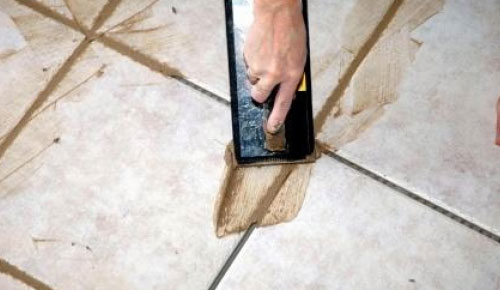-

Grouting In 6 Easy Steps
 Share on Facebook
Share on Facebook
November 26, 2016
Grouting is simply the process of filling the spaces in between each of your tiles.
Grout comes in one of two ways…
- Powder
- Premixed colors
It also comes in premixed containers with manufacturer’s instructions for mixing it.
If you want a strong and colorfast grout, you can get the right consistency by using as little water as possible. Mix very thoroughly to keep the color consistent. Only make as much as you can use before it begins to set. And then you can keep leftover dry grout for future repairs. PLEASE NOTE: You must store it in a moisture-free area.
Here are the 6 steps for applying the grout…
1. APPLY GROUT
Pour a quart to a half gallon of grout over your tile. Holding a hard-edged rubber grout float at a 45-degree angle, spread the material in sweeping arcs, pressing it firmly into the joints to fill them up. You may want to work in a small area at first — roughly a 3 x 3-foot section. You can do this for powder or pre-mix.
2. HOLD THE GROUT FLOAT AT 90-DEGREE ANGLE
Sweep the float diagonally across the tiles to remove any excess grout.
3. WIPE DOWN TILE
After a few minutes the grout will begin to harden. At that point, wipe the tiles in a circular motion with a damp sponge. CAUTION: Do not drag any of the grout from the tile corners.
4. REMOVE THE HAZE
Once the grout has hardened, the tiles will be left with a slight haze on them. Clean it up by going over the area lightly with a damp cloth, then buff immediately with a dry cloth.
5. LET GROUT DRY AND THEN APPLY SEALER
After the grout dries (follow manufacturer’s instructions), you can then apply the sealer. Simply spread the sealer with a small paintbrush or a sealer applicator. Clean off all smears quickly; within five minutes max. Then let the grout dry for a minimum of 24 hours.
6. CAULK ALONG BASEBOARDS AND WALLS
One thing to remember is that caulk is both a sealer and expansion joint. Caulk will flex if your floor expands or contracts. It will do this as the weather changes. In wet areas, in front of a bathtub or shower, or wherever the expansion gap will not be covered with shoe moulding, fill in the the gap completely with caulk and smooth it with a wet finger or other tool.
We hope you’ve enjoyed this special article. Stop in and visit us at Builder Supply Outlet where you can get more tips and strategies for improving your home.

- My account Cart
-
OPEN TO THE PUBLIC | Store Hours and Information708.343.3900 OPEN TO THE PUBLIC Store Hours and Information
- 708.343.3900 Español Schedule Your FREE
Design Consultation
